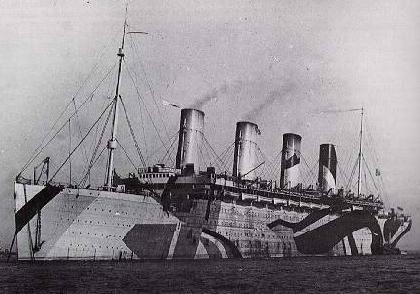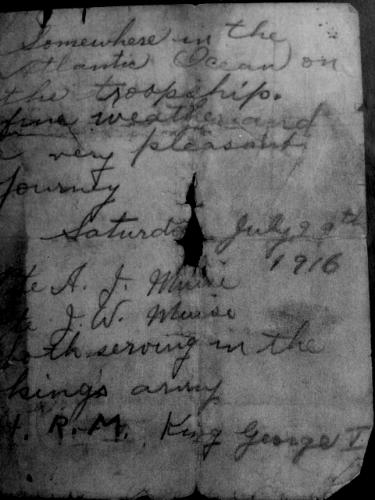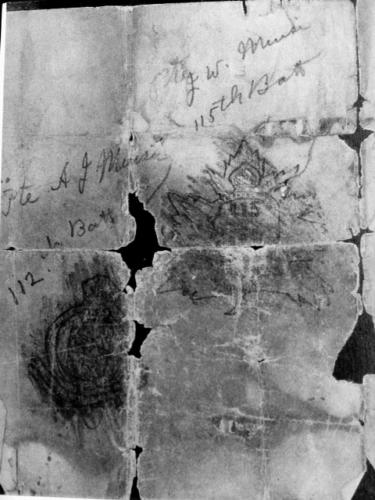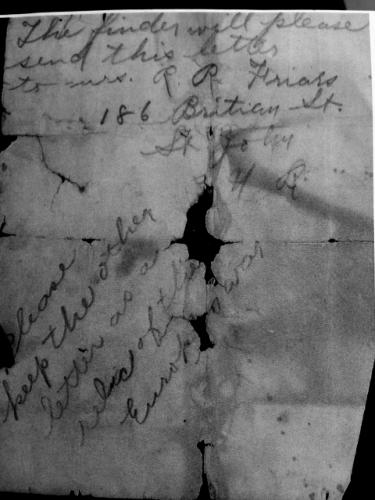
copyright © Wartime Heritage Association
Website hosting courtesy of Register.com - a web.com company
Wartime Heritage
ASSOCIATION
“Somewhere in the Atlantic Ocean on the Troopship”
It was July 23, 1916. In the early morning Pier 2 at Halifax was busy as the troop trains began arriving dockside. RMS
Olympic towered against the wooden planks of the pier below, its heavy mooring ropes taunt, as dock workers began to prepare for
the great ship’s departure. The ramps were in place. The ship’s officers would be checking the ship's manifest that listed the
cargo, and supply needs for a seven day crossing of the Atlantic.
Five battalions, with more than four thousand officers and
other ranks, would depart Halifax, Nova Scotia for Liverpool,
England later in the day. The 103rd, 109th, 112th, 115th, and
116th Battalions would provide re-enforcements for the Battalions
of the Canadian Expeditionary Force already overseas.
Soldiers with the 103rd were mainly from British Columbia.
The 109th Battalion had been formed in Ontario and had completed
four months of basic training at Barriefield, near Kingston before
departing to Halifax. The strength of that Battalion was 1050 men.
The 119th Infantry Battalion was organized at Uxbridge, Ontario,
with a strength of 943 men.
The 115th Battalion had formed in New Brunswick and had
been mobilized in St. John. That Battalion had a strength of 801
men. The 112th Battalion was from Nova Scotia. Recruitment had occurred throughout the province, with many from the Yarmouth
area. The Battalion had mobilized at Windsor, Nova Scotia and would depart Halifax with a strength of 36 Officers and 1090 other
ranks.
Alfred was seventeen, eighteen if one looked at his attestation paper. In the official military records he was Joseph Alfred
Muese. In December, he was in St. John, New Brunswick where his sister Mary (Muise) Friars lived. On December 30, 1915 Alfred
turned 17 and the following day he enlisted with the 115th Battalion. Like many other young Canadian men, he gave an incorrect
birth year on his Attestation paper, making him 18 years of age. He also gave his name incorrectly as Alfred Joseph Muese, changing
the correct spelling of “Muise”. He listed his older sister, Mary, as his next of kin. She lived in St. John and in those days, it was far
away from Yarmouth and his parents were ‘not looking over his shoulder’. He was 5 feet 5 ½ inches in height, single and a
labourer.
James, known as Jimmy, was a student in 1916. Recruitment drives in Yarmouth, Nova Scotia were persistent and the
numbers of young men enlisting were high for the area. Caught up in the patriotic fervour of the time, on February 18, 1916 Jimmy
enlisted with the 112th Battalion. He was 14 years of age, nine days short of his fifteenth birthday and a student. His official
military record listed his birth date as February 27, 1898 and his full names as James William Muise. He was 5 feet three inches in
height and weighted 135 lbs. He had enlisted as a recruit with the 29th Battery, Canadian Field Artillery at Yarmouth prior to
joining the 112th Battalion.
Alfred and James were brothers. There older brothers, George
Stanley and John Arthur, had enlisted in November of 1915. George was
serving with the 26th Battalion and Arthur the 25th Battalion. Both were
serving in France and by July 1916 had participated in the Battle of Hill
62 where Canadians had recaptured the majority of former positions lost
to the German attacks on the British lines.
By noon, on July 23, the five Battalions were boarding RMS
Olympic. Quarters were assigned and dinner was served. The RMS
Olympic had seven decks on which troops were quartered. Each soldier
was given a hammock. The two brothers were separated, each with their
own Battalion.
As the ship began to make its way out of Halifax harbour the men of
each Battalion were called to “fall in” and were issued with a life belt
which was to be worn until they reached the other side. The orders
were the only time when they could be removed is when they slept and
then it must be within arm’s length.
Alfred and Jimmy found one another among the four thousand that
roamed the decks from time to time. They had not seen each other since
Alfred had left for St. John the previous year.
RMS Olympic came out of the harbor and the shore lights could be
seen until late in the evening and eventually fading into the distance.
This was the last glimpse of Canada for the two brothers standing side by
side as the RMS Olympic cut through the waves of the Atlantic.
The following morning Reveille was at 6 a.m. and the men got up
shook blankets and rolled hammocks and went to breakfast. After
breakfast they were free to go on deck.
On July 29, the day before their arrival in Liverpool, the two boys
were together, talking about home, their family, their brothers and the
possible adventures that awaited them. They decided to write a letter
home. They had been given bibles and hunched together they concocted
little notes and a plan to trace their badges no doubt aware they may not
survive what was ahead. They tore several empty pages and traced the
outline of their Battalion badges and signed the paper with their name
and Battalion number. This was enclosed with the letter together with
several other sheets.
They read:
"Somewhere in the Atlantic Ocean on the troopship. Fine weather
and a very pleasant journey. Saturday, July 29, 1916. Pte. A. J.
Muise both serving in the kings army. H.R.M. King George V."
And on another:
"The finder will please send this letter to Mrs. R.R. Friars, 182
Britain St., St. John, N.B. Please keep the other letter as a relic of
the European war."
Two days later, RMS Olympic arrived in Liverpool and the Battalions
disembarked.
Alfred would be re-assigned to the 25th Battalion on October 5,
1916 and arrived at the Canadian Base Depot in France on July 6, 1916.
From there, he departed for the front lines on July 20, 1916 and arrived
there on July 22. He served in the front lines for six months before the
assault on Vimy Ridge. He was killed in action on April 29, 1917 during an
assault to secure the south eastern flank of Vimy toward the town of
Arleux-en-Gohelle. The attack began on September 28 and there was a
German counter-attacked on the 29; however, this was repelled but
casualties were high, The area was held and this helped secure Vimy
Ridge.
Jimmy was transferred to the Royal Canadian Regiment. He was
gassed at Passchendaele during a heavy enemy barrage that included the
use of gas shells. He was evacuated and after four months in the 16th
General Canadian Hospital was invalided home.
The two brothers did not meet again. While their letter did not
survive the years, the three additional sheets are treasured by a family
member.
They were the sons of William and Annie Muise of Yarmouth, NS.
“Somewhere in the Atlantic Ocean
on the Troopship”

RMS Olympic



SOURCES:
Soldiers of the First World War CEF. Library and Archives Canada.
photos courtesy of Josie Muise
http://regimentalrogue.com/rcr_great_war/1917_11_nov.html
http://regimentalrogue.com/rcr_great_war/Battle_Bar_Ledger_The_RCR_CEF.pdf
http://wartimeheritage.com/storyarchive1/story_miller_earle.htm
http://www.wartimeheritage.com/whawwi/whawwi_muese_alfred_joseph.htm
http://www.wartimeheritage.com/whawwi/whawwi_muise_james_william.htm
http://www.wartimeheritage.com/whawwi/whawwi_muise_george_stanley.htm
http://www.wartimeheritage.com/whawwi/whawwi_muise_arthur2.htm


- World War I - Menu
- WWI Stories and Articles
- Photos - Yarmouth Soldiers
- Selection of World War I Songs
- WWI Casualties of Yarmouth, NS
- Those Who Served - Yarmouth, NS
- WWI Casualties Digby Co. NS
- WWI Casualties Shelburne Co. NS
- Merchant Mariners (1915) Yarmouth, NS
- Canadian Forestry Corps - Non Yarmouth Birth/Residence Enlistments
- US Draft Registry - Yarmouth NS Born


- World War II - Menu
- WWII Stories and Articles
- Telegraphist Air Gunners
- WWII Casualties of Nova Scotia
- US Casualties with NS Connection
- Far East/Pacific Casualties with NS Connection
- Merchant Navy Casualties Nova Scotia
- Nova Scotia WWII Casualties Holten Canadian War Cemetery
- D-Day Casualties - Nova Scotia
- CANLOAN Program Casualties - Nova Scotia
- Battle of the Bulge Casualties - Nova Scotia
- WWII Casualties Yarmouth NS
- Yarmouth Casualties - RCAF RAF Canadian Army WWII
- Yarmouth Co., Marriages WWII
- Casualties Non-Born/Residents with Connection to Yarmouth Co., Nova Scotia.
- WWII Casualties Digby Co., NS
- Non-Nova Scotian WWII Casualties Buried in Nova Scotia
- WWII RCAF Casualties Aged 16-18
- Brothers/Sisters Who Served - World War II














